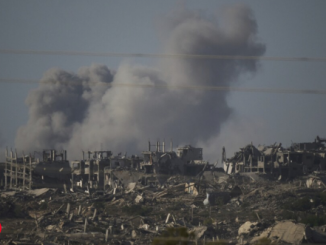
Hamas operatives seen as aid trucks arrive in Rafah, Gaza Strip, January 21, 2025. (Jehad Alshrafi/AP)
| Published April 18, 2025
Sources tell Wall Street Journal terror group used seized goods from humanitarian aid supplies to raise money, but with deliveries cut off, it is running out of resources
A recent Wall Street Journal investigation has shed light on the intricate financial mechanisms that enable Hamas to sustain its operations in Gaza. The report underscores the group’s reliance on a multifaceted funding network, encompassing state sponsorships, cryptocurrency transactions, and taxation within Gaza.
State Sponsorship and International Support
Iran remains a principal benefactor of Hamas, providing substantial financial assistance. Estimates suggest that Iran contributes between $70 million and $100 million annually to Hamas’s armed wing. Additionally, Qatar has been identified as a significant financial supporter, transferring over $1.8 billion to Hamas over the years.
Cryptocurrency and Financial Evasion
In response to increased scrutiny and sanctions, Hamas has turned to cryptocurrencies to facilitate anonymous transactions. Between August 2021 and June 2023, Hamas reportedly received approximately $41 million in cryptocurrency donations. These digital assets allow the group to bypass traditional banking systems, making it challenging for international regulators to trace and intercept funds.
Taxation and Economic Control in Gaza
Within Gaza, Hamas exerts significant control over economic activities, imposing taxes and levies on goods and services. This internal revenue generation is estimated to bring in as much as $400 million per year, further bolstering the group’s financial stability.
Implications and International Response
The revelation of Hamas’s diversified funding sources has prompted renewed efforts by international bodies to disrupt these financial channels. The U.S. Treasury Department has emphasized its commitment to dismantling Hamas’s financial networks, recognizing the group’s ability to adapt and sustain its operations through various means.
Understanding the complexity of Hamas’s financial infrastructure is crucial for developing effective strategies to counter its influence and activities. The group’s ability to leverage both traditional and modern financial systems underscores the need for a comprehensive and coordinated international approach to address the challenges posed by such organizations.
Here’s a balanced look at the pros and cons of the Wall Street Journal’s feature on Hamas’s finances in Gaza:
✅ PROS
1. Exposes Complex Funding Channels
The article details how Hamas funds its operations through a mix of state sponsorship, cryptocurrency, and local taxation. This level of transparency helps readers understand how terrorist networks sustain themselves globally.
2. Informs Policy and Public Debate
By providing specific figures and sources, it offers valuable insights for policymakers, financial regulators, and counterterrorism agencies aiming to cut off terror financing.
3. Highlights Global Complicity
Naming countries like Iran and Qatar as major financial backers brings attention to state-level support for extremist groups—pressuring governments to reassess foreign aid and diplomatic relationships.
4. Sheds Light on Cryptocurrency’s Dark Side
The article raises awareness about how digital currencies can be exploited for illicit activities, prompting calls for stricter crypto regulations.
5. Encourages International Action
It galvanizes global actors to act—whether by enforcing sanctions, tightening border controls, or supporting Israel’s security objectives.
❌ CONS
1. May Oversimplify or Generalize
While Hamas is the focus, the article may inadvertently lead to the conflation of Palestinians or Gazans with terrorism, fueling broad stereotypes and Islamophobia.
2. Lacks Voices from Gaza
The article focuses on Hamas leadership and funding but may not sufficiently represent the suffering of innocent Gazans caught in the crossfire or under oppressive rule.
3. Could Escalate Tensions
Publicizing the extent of Hamas’s funding might embolden more aggressive military responses or deepen regional instability, especially if used to justify expanded operations.
4. Potential Political Weaponization
The feature could be leveraged by political groups (especially in the U.S. or Israel) to shut down nuanced discussions about humanitarian aid, ceasefires, or peace negotiations.
5. Leaves Gaps on Enforcement
While it reveals funding streams, the article doesn’t fully explore what enforcement mechanisms have succeeded or failed in stopping them, leaving readers without a clear path forward.
🧾 Conclusion
The Wall Street Journal’s exposé on Hamas’s finances delivers a critical examination of how a terrorist organization like Hamas sustains its operations through a sophisticated web of international backing, digital currencies, and local taxation. While it provides valuable insights that can inform counterterrorism strategies and policy decisions, it also carries the risk of reinforcing stereotypes and contributing to political polarization if not interpreted with care.
Ultimately, the article underscores a vital truth: combating terrorism isn’t just about military might—it’s about understanding and dismantling the financial lifelines that keep these groups alive. But in doing so, the international community must also ensure that innocent civilians aren’t unjustly vilified or caught in the fallout of sweeping judgments. Balanced reporting and responsible interpretation remain key to addressing both the security threats and the humanitarian realities on the ground.
SOURCES: THE WALL STREET JOURNAL – A Depleted Hamas Is So Low on Cash That It Can’t Pay Its Fighters
ZEROHEDGE – Cash-Strapped Hamas Can’t Pay Its Fighters
THE TIMES OF ISRAEL – Cash-strapped Hamas can’t pay fighters as Israeli offensive hits funding sources — report




